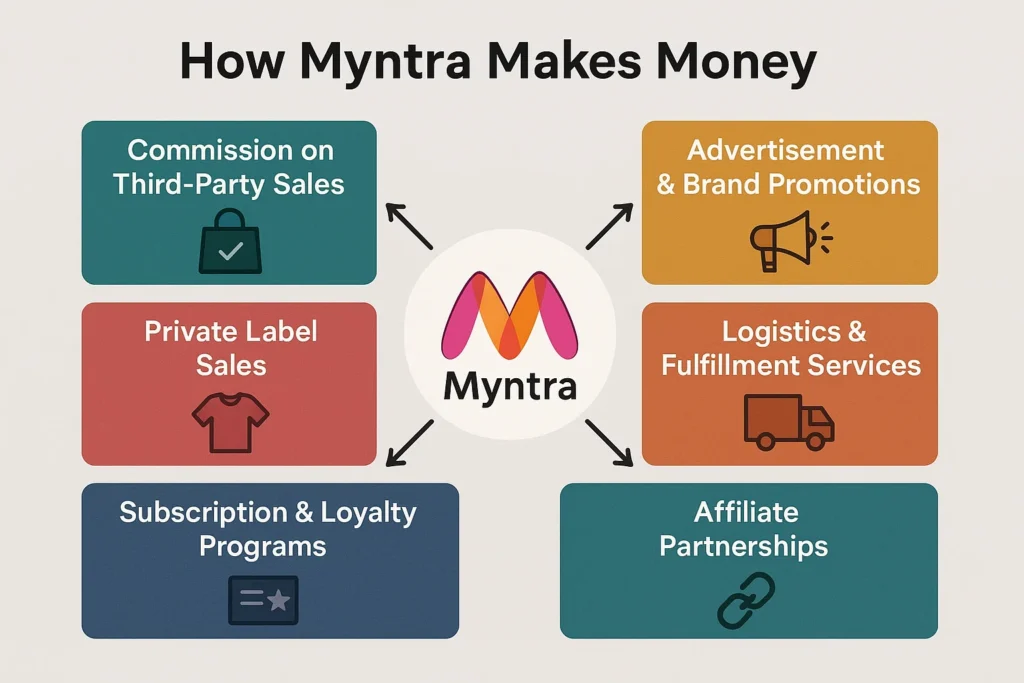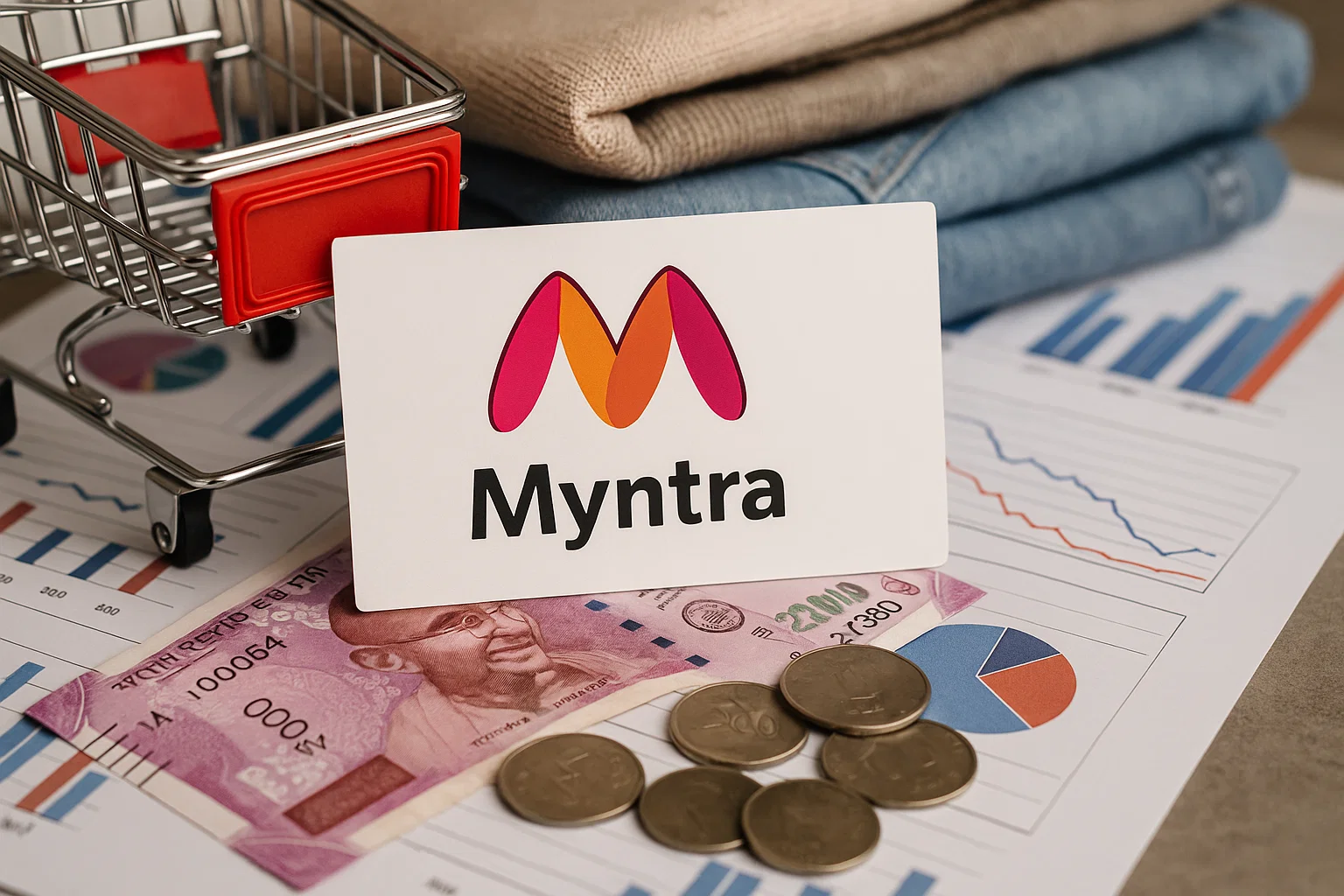Myntra has grown from a startup to India’s leading online fashion and lifestyle destination. With a laser focus on curated fashion, personalized shopping, and smooth delivery, it dominates the eCommerce fashion sector with millions of monthly active users. Backed by Flipkart (and owned by Walmart), Myntra has become a household name for digital-first fashion shoppers.
What makes Myntra unique is not just its catalog or user experience — it’s the strategic way the platform generates revenue. From brand partnerships and marketplace commissions to ads and in-house labels, Myntra’s monetization engine is diverse, scalable, and highly optimized for the fashion-forward consumer.
In this blog, we’ll decode how Myntra earns money, examine its revenue streams, and explain how startups can launch similar platforms using Miracuves’ ready-made Myntra Clone.
Build your own Flipkart or Amazon-style platform with a leading e-commerce app development company trusted by global startups and enterprises.
How Myntra Makes Money
Myntra operates a multi-layered revenue model that blends marketplace dynamics with brand control. Here are the major ways Myntra monetizes its fashion platform:
- Commission on Third-Party Sales – Myntra charges a commission on each sale made by brands and sellers listed on the platform.
- Private Label Sales – Myntra owns several in-house fashion brands like Roadster, HRX, DressBerry, and more — earning full margins.
- Advertisement & Brand Promotions – Brands pay Myntra for in-app visibility, banner placements, and influencer-led campaigns.
- Logistics & Fulfillment Services – Myntra charges sellers for warehousing, packaging, and last-mile delivery through its logistics arm.
- Subscription & Loyalty Programs – With offerings like Myntra Insider, the platform boosts user retention while offering paid brand perks.
- Affiliate Partnerships – Myntra earns from external links, influencer promotions, and affiliate-driven traffic that leads to conversions.

This revenue strategy allows Myntra to thrive in both high-volume transactions and high-margin product categories — making it a hybrid of a marketplace and a fashion house.
Read More :- What is Myntra App and How Does It Work?
Detailed Breakdown of Revenue Channels
Commission on Third-Party Sales
Myntra operates on a marketplace model for most brands. Sellers list their products, and Myntra takes a commission on each sale — typically ranging from 5% to 20%, depending on category and brand agreement.
- Who Pays? Third-party fashion brands and retailers.
- Why It Scales? More sellers = more SKUs = more transactions, without inventory risk.
Private Label Sales
Myntra owns successful in-house brands like Roadster, HRX (with Hrithik Roshan), DressBerry, Anouk, and Mast & Harbour. These private labels offer higher profit margins as Myntra controls design, manufacturing, pricing, and marketing.
- Who Pays? End customers.
- Why It Scales? Full control over margins, branding, and inventory; creates brand differentiation.
Advertisement & Brand Promotions
Fashion brands pay Myntra to gain prime placements in the app, homepage banners, push notifications, influencer campaigns, and during flagship events like “End of Reason Sale.” This advertising revenue is a powerful non-transactional stream.
- Who Pays? Fashion brands, advertisers, lifestyle partners.
- Why It Scales? More traffic = more ad revenue. It’s high-margin and doesn’t rely on sales volume.
Logistics & Fulfillment Services
Myntra provides end-to-end fulfillment services under its supply chain division, charging sellers for packaging, warehousing (under “Myntra Smart”), and delivery. It ensures a consistent customer experience while monetizing the backend.
- Who Pays? Brands and third-party sellers using Myntra’s logistics.
- Why It Scales? Recurring fees from thousands of sellers using its delivery stack.
Subscription & Loyalty Programs
Myntra Insider is the platform’s loyalty program that offers early access, partner deals, and brand perks. Though currently free, monetizable tiers and paid access partnerships with fashion and fitness brands (like Cult.fit) offer added income potential.
- Who Pays? Consumers and partner brands.
- Why It Scales? Boosts repeat purchases, retention, and cross-promotional income.
Affiliate Partnerships
Myntra works with influencers, content creators, and affiliate marketers. For each successful referral or conversion via tracked links or campaigns, Myntra pays a cut — while keeping the rest as pure profit.
- Who Pays? Myntra funds it, but revenue comes from referred purchases.
- Why It Scales? Influencer commerce is booming, especially in fashion.
Also Read :-The Business Model of Myntra’s Success | What Startups Can Learn
Why This Revenue Model Works in 2025
Myntra’s revenue model isn’t just effective — it’s built for the digital-native, fashion-conscious consumer of 2025. Several market and tech shifts are reinforcing its success:
D2C & Marketplace Hybrid Trend
Consumers increasingly prefer buying directly from brands, but marketplaces still offer unmatched convenience. Myntra’s model combines both — giving brands control while offering users variety, trust, and fast delivery.
Explosion of Fashion-Driven E-Commerce
With rising disposable income and youth-focused fashion culture, India’s online apparel market is booming. Myntra taps into this by offering everything from budget-friendly to premium, all under one umbrella.
Influencer-Led Shopping & Social Commerce
2025 shoppers trust creators more than ads. Myntra’s affiliate and promotion model rides this wave with creator tie-ups and exclusive brand drops, turning content into conversions.
High Retention Through Loyalty Ecosystem
Myntra Insider and gamified reward systems keep users engaged across seasons and sale events. In a market where CAC is rising, this lowers churn and increases customer lifetime value.
AI-Powered Personalization & Dynamic Pricing
From personalized feeds to real-time product recommendations and price optimization, Myntra leverages AI to boost order size and frequency — supporting both ad revenue and conversions.
Learn More :-Myntra Marketing Strategy: Lessons for Fashion Startups
Can Startups Replicate Myntra’s Revenue Model?
Yes — but replicating Myntra’s success takes more than just uploading products to a website.
Startups face hurdles like tech scalability, brand acquisition, inventory control, dynamic pricing systems, and delivering a personalized experience at scale. Building this from scratch would require months of development, deep fashion tech expertise, and substantial investment in logistics and UI/UX optimization.
But with Miracuves’ ready-made Myntra Clone, these barriers disappear.
Our solution lets entrepreneurs launch a full-featured fashion marketplace with monetization levers already built in:
- Commission setup for multi-vendor fashion sales
- Private label support and backend inventory management
- Advertising modules for brand promotions
- Loyalty system and subscription-ready modules
- Seller dashboards and integrated logistics options
- Mobile-first UI optimized for product discovery and conversion
Startups and digital agencies can white-label the Myntra Clone, customize the features, and go live in weeks — not months. The result? A revenue-ready fashion app backed by proven infrastructure and monetization flows.
The Myntra Clone by Miracuves is priced at $2,899, designed for fashion, apparel, and lifestyle eCommerce brands.
Build a stylish, scalable, and feature-rich marketplace with smooth shopping experiences.
Go live in just 3–6 days with 60 days of tech support.
Read More :-Reasons startup choose our myntra clone over custom development
Conclusion
Myntra’s revenue model is a well-oiled blend of marketplace commissions, private label profits, brand advertising, logistics income, and affiliate growth. It thrives because it meets both brand needs and user expectations — offering convenience, personalization, and style at scale.
In 2025, this model is more relevant than ever thanks to shifts in consumer behavior, digital fashion adoption, and the rise of social commerce.
The best part? You don’t need to build it from scratch.
With Miracuves’ Myntra Clone, you can launch a powerful fashion commerce platform that mirrors the same monetization strategy — complete with commission logic, ad placements, loyalty programs, and more.
FAQs
How does Myntra generate revenue?
Myntra earns revenue through commissions on brand sales, its private label products, advertising services, logistics solutions, loyalty programs, and affiliate marketing. This hybrid model blends high-volume and high-margin income.
Is Myntra profitable in 2025?
While Myntra invests heavily in tech and marketing, its diverse revenue streams — especially from private labels and brand ads — have helped it move closer to profitability as per recent reports.
What are the main income sources for Myntra?
Key income streams include marketplace commissions, direct sales of Myntra-owned fashion brands, paid promotions, fulfillment services, and customer engagement programs like Myntra Insider.
Can startups use the same revenue model as Myntra?
Yes. With the right tech stack and marketplace infrastructure, startups can adopt Myntra’s monetization model. Using a prebuilt Myntra Clone from Miracuves makes this faster and more affordable.
Does Miracuves offer a Myntra clone with monetization features?
Absolutely. Miracuves provides a customizable Myntra Clone with built-in revenue tools — from commission engines to ad modules and loyalty programs — helping startups monetize from day one.








